Case Study Analysis: CBA Money Laundering and Ethics in Finance
VerifiedAdded on 2022/08/31
|11
|2779
|21
Case Study
AI Summary
This case study analyzes the Commonwealth Bank of Australia (CBA) money laundering scandal, examining ethical violations and failures in compliance with anti-money laundering (AML) and counter-terrorist financing (CTF) regulations. The analysis covers the violation of ethics and standards, stakeholder impacts (including the bank, customers, shareholders, and regulators), and the application of ethical theories such as Friedman's Individualism and Virtue Theory. It delves into the moral development stages according to Lawrence Kohlberg, evaluating the actions of CBA executives and the impact on corporate culture and governance. The case study further explores the ethical code of Australian banks, the role of AUSTRAC, and the consequences of the scandal, including the fine imposed on CBA. Finally, the assignment assesses the effectiveness of the Banking Code of Practice in addressing the ethical failures. The analysis demonstrates the importance of ethical behavior, regulatory compliance, and robust corporate governance in the financial industry.
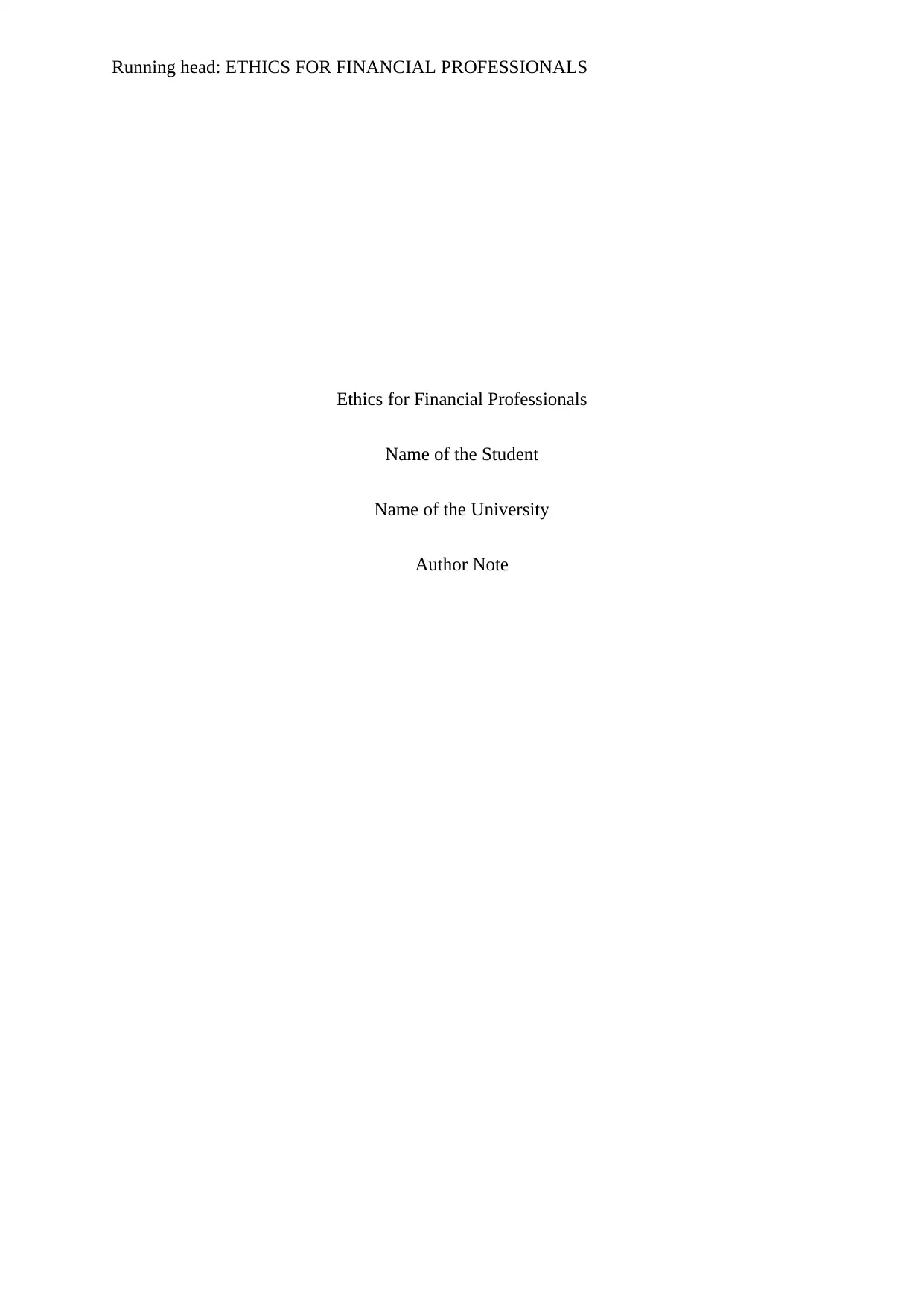
Running head: ETHICS FOR FINANCIAL PROFESSIONALS
Ethics for Financial Professionals
Name of the Student
Name of the University
Author Note
Ethics for Financial Professionals
Name of the Student
Name of the University
Author Note
Paraphrase This Document
Need a fresh take? Get an instant paraphrase of this document with our AI Paraphraser
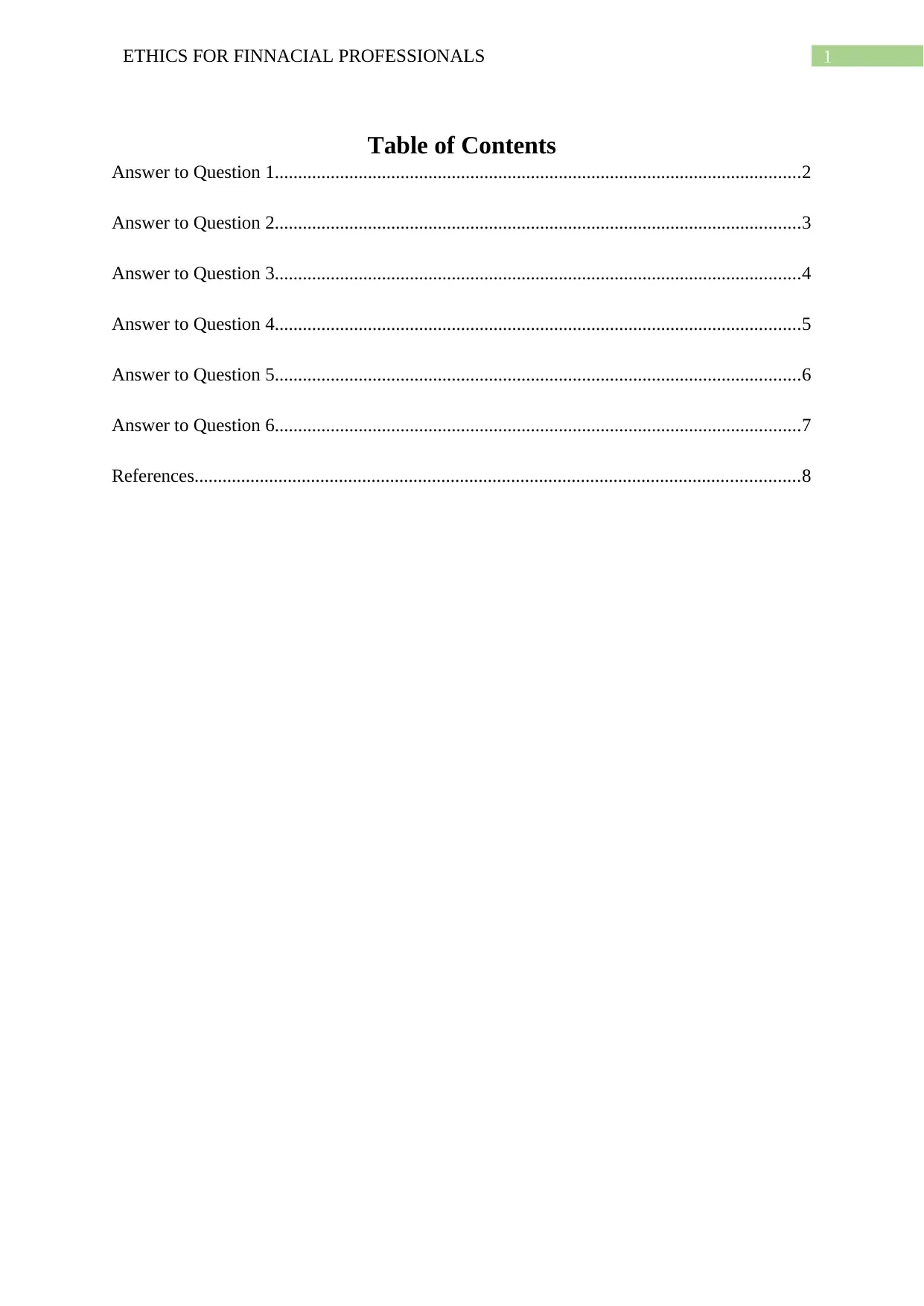
1ETHICS FOR FINNACIAL PROFESSIONALS
Table of Contents
Answer to Question 1.................................................................................................................2
Answer to Question 2.................................................................................................................3
Answer to Question 3.................................................................................................................4
Answer to Question 4.................................................................................................................5
Answer to Question 5.................................................................................................................6
Answer to Question 6.................................................................................................................7
References..................................................................................................................................8
Table of Contents
Answer to Question 1.................................................................................................................2
Answer to Question 2.................................................................................................................3
Answer to Question 3.................................................................................................................4
Answer to Question 4.................................................................................................................5
Answer to Question 5.................................................................................................................6
Answer to Question 6.................................................................................................................7
References..................................................................................................................................8
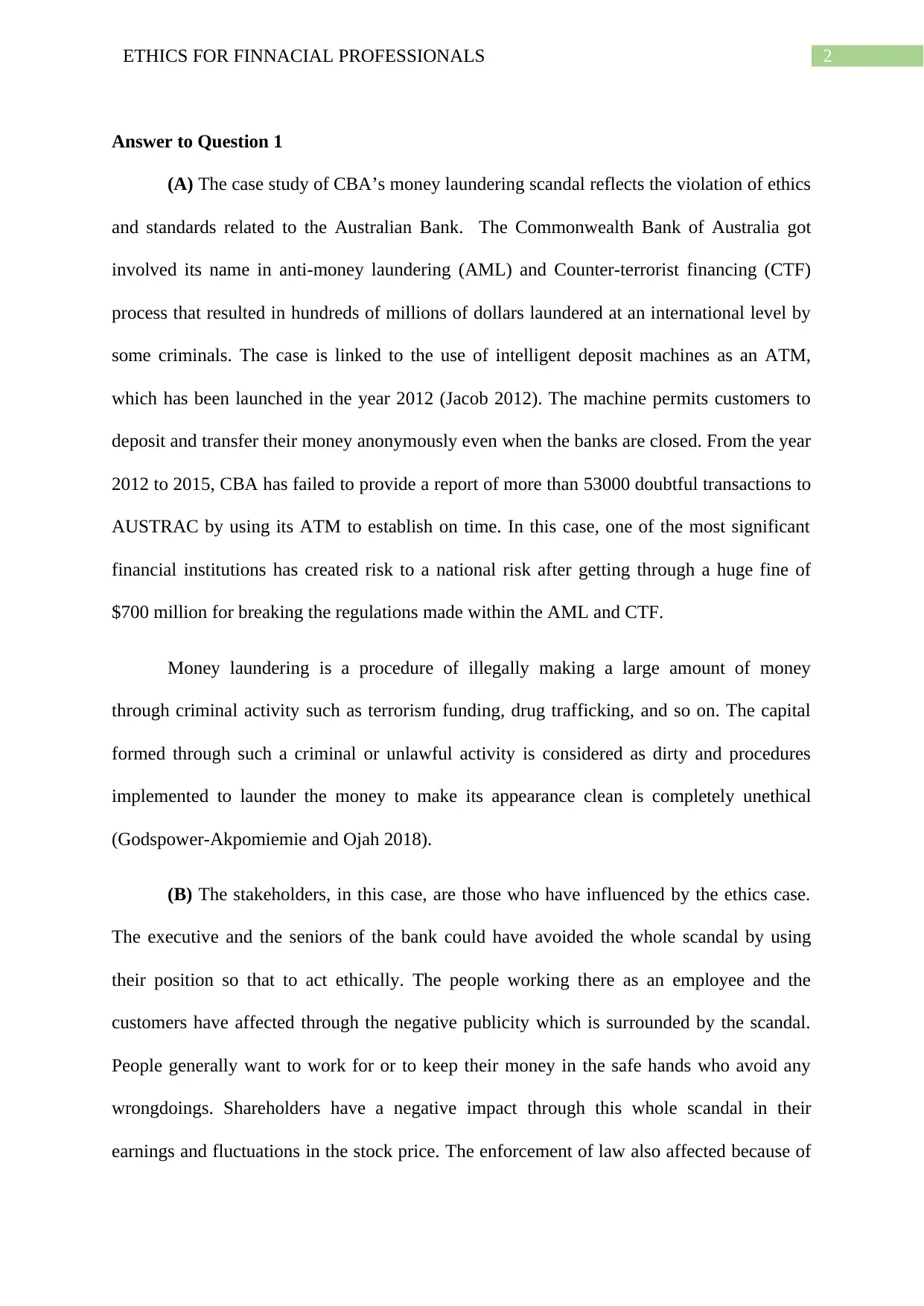
2ETHICS FOR FINNACIAL PROFESSIONALS
Answer to Question 1
(A) The case study of CBA’s money laundering scandal reflects the violation of ethics
and standards related to the Australian Bank. The Commonwealth Bank of Australia got
involved its name in anti-money laundering (AML) and Counter-terrorist financing (CTF)
process that resulted in hundreds of millions of dollars laundered at an international level by
some criminals. The case is linked to the use of intelligent deposit machines as an ATM,
which has been launched in the year 2012 (Jacob 2012). The machine permits customers to
deposit and transfer their money anonymously even when the banks are closed. From the year
2012 to 2015, CBA has failed to provide a report of more than 53000 doubtful transactions to
AUSTRAC by using its ATM to establish on time. In this case, one of the most significant
financial institutions has created risk to a national risk after getting through a huge fine of
$700 million for breaking the regulations made within the AML and CTF.
Money laundering is a procedure of illegally making a large amount of money
through criminal activity such as terrorism funding, drug trafficking, and so on. The capital
formed through such a criminal or unlawful activity is considered as dirty and procedures
implemented to launder the money to make its appearance clean is completely unethical
(Godspower-Akpomiemie and Ojah 2018).
(B) The stakeholders, in this case, are those who have influenced by the ethics case.
The executive and the seniors of the bank could have avoided the whole scandal by using
their position so that to act ethically. The people working there as an employee and the
customers have affected through the negative publicity which is surrounded by the scandal.
People generally want to work for or to keep their money in the safe hands who avoid any
wrongdoings. Shareholders have a negative impact through this whole scandal in their
earnings and fluctuations in the stock price. The enforcement of law also affected because of
Answer to Question 1
(A) The case study of CBA’s money laundering scandal reflects the violation of ethics
and standards related to the Australian Bank. The Commonwealth Bank of Australia got
involved its name in anti-money laundering (AML) and Counter-terrorist financing (CTF)
process that resulted in hundreds of millions of dollars laundered at an international level by
some criminals. The case is linked to the use of intelligent deposit machines as an ATM,
which has been launched in the year 2012 (Jacob 2012). The machine permits customers to
deposit and transfer their money anonymously even when the banks are closed. From the year
2012 to 2015, CBA has failed to provide a report of more than 53000 doubtful transactions to
AUSTRAC by using its ATM to establish on time. In this case, one of the most significant
financial institutions has created risk to a national risk after getting through a huge fine of
$700 million for breaking the regulations made within the AML and CTF.
Money laundering is a procedure of illegally making a large amount of money
through criminal activity such as terrorism funding, drug trafficking, and so on. The capital
formed through such a criminal or unlawful activity is considered as dirty and procedures
implemented to launder the money to make its appearance clean is completely unethical
(Godspower-Akpomiemie and Ojah 2018).
(B) The stakeholders, in this case, are those who have influenced by the ethics case.
The executive and the seniors of the bank could have avoided the whole scandal by using
their position so that to act ethically. The people working there as an employee and the
customers have affected through the negative publicity which is surrounded by the scandal.
People generally want to work for or to keep their money in the safe hands who avoid any
wrongdoings. Shareholders have a negative impact through this whole scandal in their
earnings and fluctuations in the stock price. The enforcement of law also affected because of
⊘ This is a preview!⊘
Do you want full access?
Subscribe today to unlock all pages.

Trusted by 1+ million students worldwide
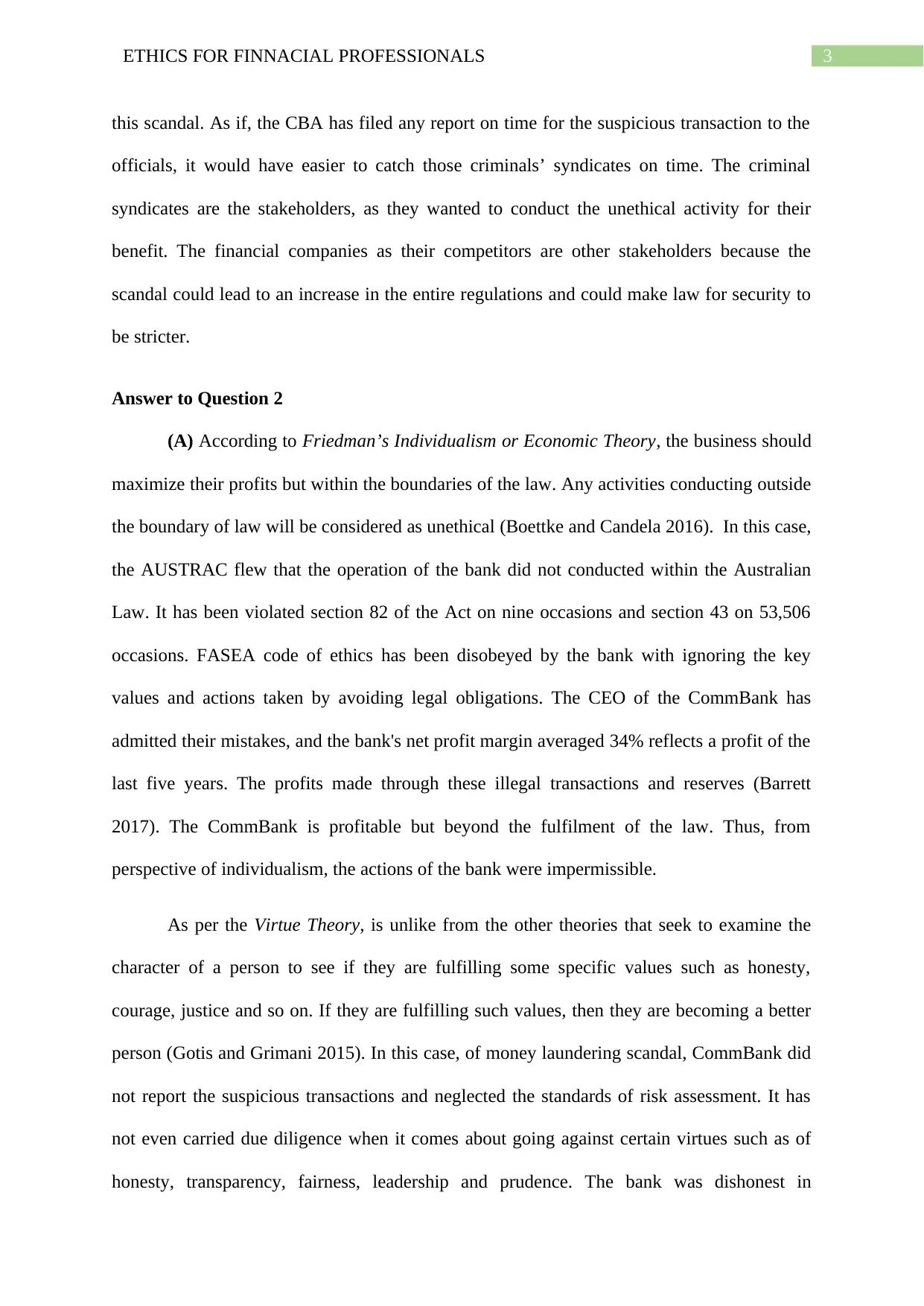
3ETHICS FOR FINNACIAL PROFESSIONALS
this scandal. As if, the CBA has filed any report on time for the suspicious transaction to the
officials, it would have easier to catch those criminals’ syndicates on time. The criminal
syndicates are the stakeholders, as they wanted to conduct the unethical activity for their
benefit. The financial companies as their competitors are other stakeholders because the
scandal could lead to an increase in the entire regulations and could make law for security to
be stricter.
Answer to Question 2
(A) According to Friedman’s Individualism or Economic Theory, the business should
maximize their profits but within the boundaries of the law. Any activities conducting outside
the boundary of law will be considered as unethical (Boettke and Candela 2016). In this case,
the AUSTRAC flew that the operation of the bank did not conducted within the Australian
Law. It has been violated section 82 of the Act on nine occasions and section 43 on 53,506
occasions. FASEA code of ethics has been disobeyed by the bank with ignoring the key
values and actions taken by avoiding legal obligations. The CEO of the CommBank has
admitted their mistakes, and the bank's net profit margin averaged 34% reflects a profit of the
last five years. The profits made through these illegal transactions and reserves (Barrett
2017). The CommBank is profitable but beyond the fulfilment of the law. Thus, from
perspective of individualism, the actions of the bank were impermissible.
As per the Virtue Theory, is unlike from the other theories that seek to examine the
character of a person to see if they are fulfilling some specific values such as honesty,
courage, justice and so on. If they are fulfilling such values, then they are becoming a better
person (Gotis and Grimani 2015). In this case, of money laundering scandal, CommBank did
not report the suspicious transactions and neglected the standards of risk assessment. It has
not even carried due diligence when it comes about going against certain virtues such as of
honesty, transparency, fairness, leadership and prudence. The bank was dishonest in
this scandal. As if, the CBA has filed any report on time for the suspicious transaction to the
officials, it would have easier to catch those criminals’ syndicates on time. The criminal
syndicates are the stakeholders, as they wanted to conduct the unethical activity for their
benefit. The financial companies as their competitors are other stakeholders because the
scandal could lead to an increase in the entire regulations and could make law for security to
be stricter.
Answer to Question 2
(A) According to Friedman’s Individualism or Economic Theory, the business should
maximize their profits but within the boundaries of the law. Any activities conducting outside
the boundary of law will be considered as unethical (Boettke and Candela 2016). In this case,
the AUSTRAC flew that the operation of the bank did not conducted within the Australian
Law. It has been violated section 82 of the Act on nine occasions and section 43 on 53,506
occasions. FASEA code of ethics has been disobeyed by the bank with ignoring the key
values and actions taken by avoiding legal obligations. The CEO of the CommBank has
admitted their mistakes, and the bank's net profit margin averaged 34% reflects a profit of the
last five years. The profits made through these illegal transactions and reserves (Barrett
2017). The CommBank is profitable but beyond the fulfilment of the law. Thus, from
perspective of individualism, the actions of the bank were impermissible.
As per the Virtue Theory, is unlike from the other theories that seek to examine the
character of a person to see if they are fulfilling some specific values such as honesty,
courage, justice and so on. If they are fulfilling such values, then they are becoming a better
person (Gotis and Grimani 2015). In this case, of money laundering scandal, CommBank did
not report the suspicious transactions and neglected the standards of risk assessment. It has
not even carried due diligence when it comes about going against certain virtues such as of
honesty, transparency, fairness, leadership and prudence. The bank was dishonest in
Paraphrase This Document
Need a fresh take? Get an instant paraphrase of this document with our AI Paraphraser
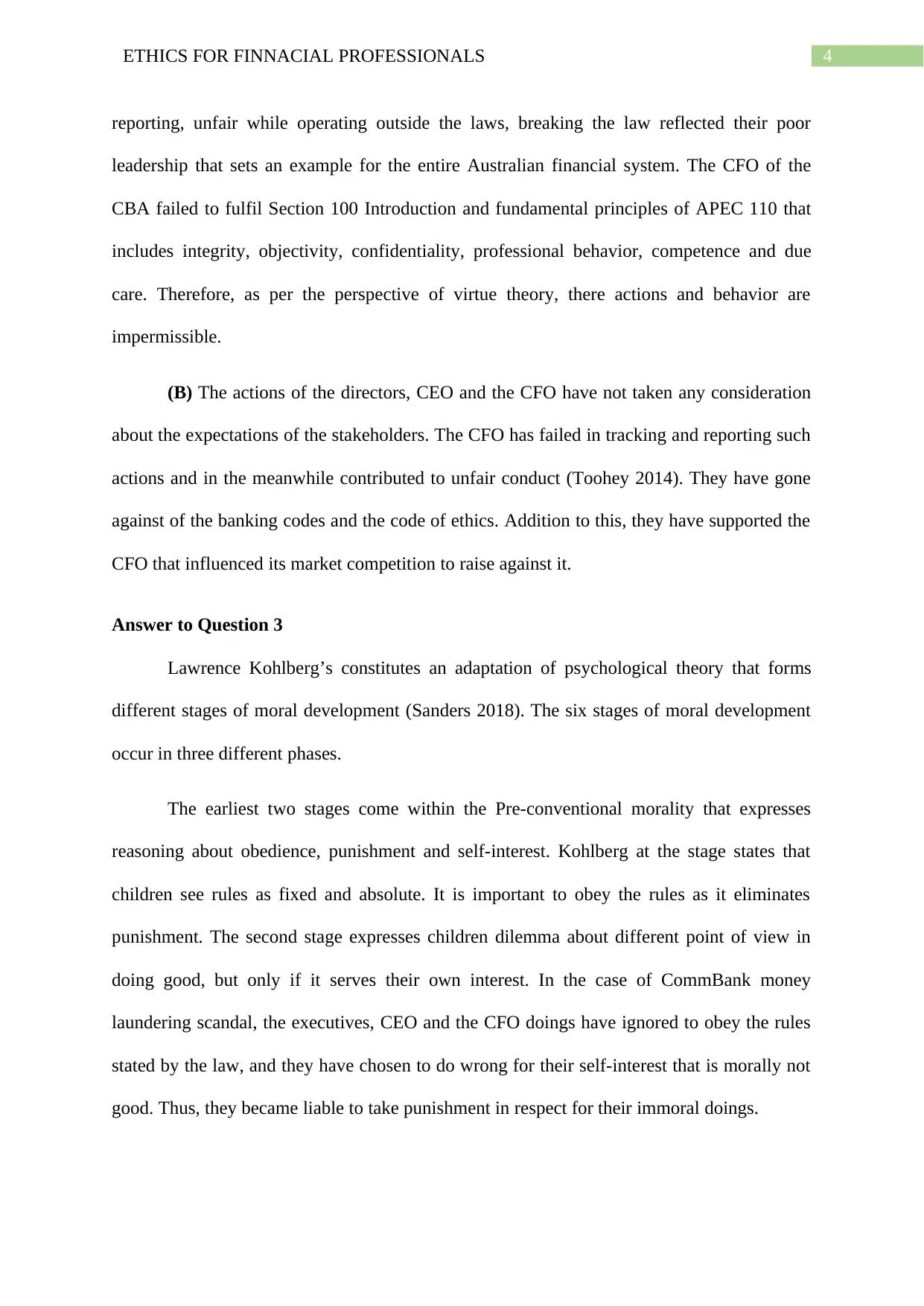
4ETHICS FOR FINNACIAL PROFESSIONALS
reporting, unfair while operating outside the laws, breaking the law reflected their poor
leadership that sets an example for the entire Australian financial system. The CFO of the
CBA failed to fulfil Section 100 Introduction and fundamental principles of APEC 110 that
includes integrity, objectivity, confidentiality, professional behavior, competence and due
care. Therefore, as per the perspective of virtue theory, there actions and behavior are
impermissible.
(B) The actions of the directors, CEO and the CFO have not taken any consideration
about the expectations of the stakeholders. The CFO has failed in tracking and reporting such
actions and in the meanwhile contributed to unfair conduct (Toohey 2014). They have gone
against of the banking codes and the code of ethics. Addition to this, they have supported the
CFO that influenced its market competition to raise against it.
Answer to Question 3
Lawrence Kohlberg’s constitutes an adaptation of psychological theory that forms
different stages of moral development (Sanders 2018). The six stages of moral development
occur in three different phases.
The earliest two stages come within the Pre-conventional morality that expresses
reasoning about obedience, punishment and self-interest. Kohlberg at the stage states that
children see rules as fixed and absolute. It is important to obey the rules as it eliminates
punishment. The second stage expresses children dilemma about different point of view in
doing good, but only if it serves their own interest. In the case of CommBank money
laundering scandal, the executives, CEO and the CFO doings have ignored to obey the rules
stated by the law, and they have chosen to do wrong for their self-interest that is morally not
good. Thus, they became liable to take punishment in respect for their immoral doings.
reporting, unfair while operating outside the laws, breaking the law reflected their poor
leadership that sets an example for the entire Australian financial system. The CFO of the
CBA failed to fulfil Section 100 Introduction and fundamental principles of APEC 110 that
includes integrity, objectivity, confidentiality, professional behavior, competence and due
care. Therefore, as per the perspective of virtue theory, there actions and behavior are
impermissible.
(B) The actions of the directors, CEO and the CFO have not taken any consideration
about the expectations of the stakeholders. The CFO has failed in tracking and reporting such
actions and in the meanwhile contributed to unfair conduct (Toohey 2014). They have gone
against of the banking codes and the code of ethics. Addition to this, they have supported the
CFO that influenced its market competition to raise against it.
Answer to Question 3
Lawrence Kohlberg’s constitutes an adaptation of psychological theory that forms
different stages of moral development (Sanders 2018). The six stages of moral development
occur in three different phases.
The earliest two stages come within the Pre-conventional morality that expresses
reasoning about obedience, punishment and self-interest. Kohlberg at the stage states that
children see rules as fixed and absolute. It is important to obey the rules as it eliminates
punishment. The second stage expresses children dilemma about different point of view in
doing good, but only if it serves their own interest. In the case of CommBank money
laundering scandal, the executives, CEO and the CFO doings have ignored to obey the rules
stated by the law, and they have chosen to do wrong for their self-interest that is morally not
good. Thus, they became liable to take punishment in respect for their immoral doings.
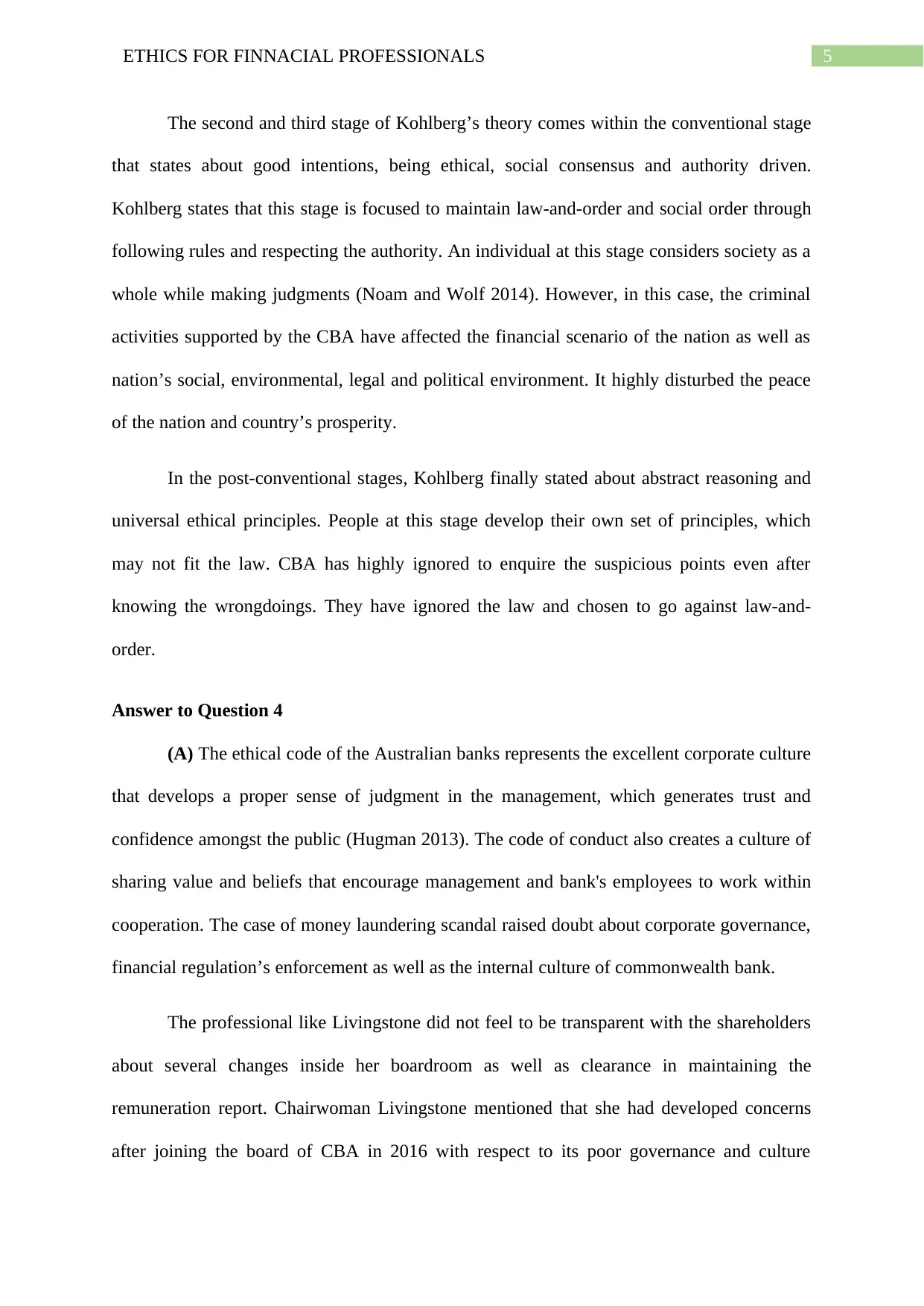
5ETHICS FOR FINNACIAL PROFESSIONALS
The second and third stage of Kohlberg’s theory comes within the conventional stage
that states about good intentions, being ethical, social consensus and authority driven.
Kohlberg states that this stage is focused to maintain law-and-order and social order through
following rules and respecting the authority. An individual at this stage considers society as a
whole while making judgments (Noam and Wolf 2014). However, in this case, the criminal
activities supported by the CBA have affected the financial scenario of the nation as well as
nation’s social, environmental, legal and political environment. It highly disturbed the peace
of the nation and country’s prosperity.
In the post-conventional stages, Kohlberg finally stated about abstract reasoning and
universal ethical principles. People at this stage develop their own set of principles, which
may not fit the law. CBA has highly ignored to enquire the suspicious points even after
knowing the wrongdoings. They have ignored the law and chosen to go against law-and-
order.
Answer to Question 4
(A) The ethical code of the Australian banks represents the excellent corporate culture
that develops a proper sense of judgment in the management, which generates trust and
confidence amongst the public (Hugman 2013). The code of conduct also creates a culture of
sharing value and beliefs that encourage management and bank's employees to work within
cooperation. The case of money laundering scandal raised doubt about corporate governance,
financial regulation’s enforcement as well as the internal culture of commonwealth bank.
The professional like Livingstone did not feel to be transparent with the shareholders
about several changes inside her boardroom as well as clearance in maintaining the
remuneration report. Chairwoman Livingstone mentioned that she had developed concerns
after joining the board of CBA in 2016 with respect to its poor governance and culture
The second and third stage of Kohlberg’s theory comes within the conventional stage
that states about good intentions, being ethical, social consensus and authority driven.
Kohlberg states that this stage is focused to maintain law-and-order and social order through
following rules and respecting the authority. An individual at this stage considers society as a
whole while making judgments (Noam and Wolf 2014). However, in this case, the criminal
activities supported by the CBA have affected the financial scenario of the nation as well as
nation’s social, environmental, legal and political environment. It highly disturbed the peace
of the nation and country’s prosperity.
In the post-conventional stages, Kohlberg finally stated about abstract reasoning and
universal ethical principles. People at this stage develop their own set of principles, which
may not fit the law. CBA has highly ignored to enquire the suspicious points even after
knowing the wrongdoings. They have ignored the law and chosen to go against law-and-
order.
Answer to Question 4
(A) The ethical code of the Australian banks represents the excellent corporate culture
that develops a proper sense of judgment in the management, which generates trust and
confidence amongst the public (Hugman 2013). The code of conduct also creates a culture of
sharing value and beliefs that encourage management and bank's employees to work within
cooperation. The case of money laundering scandal raised doubt about corporate governance,
financial regulation’s enforcement as well as the internal culture of commonwealth bank.
The professional like Livingstone did not feel to be transparent with the shareholders
about several changes inside her boardroom as well as clearance in maintaining the
remuneration report. Chairwoman Livingstone mentioned that she had developed concerns
after joining the board of CBA in 2016 with respect to its poor governance and culture
⊘ This is a preview!⊘
Do you want full access?
Subscribe today to unlock all pages.

Trusted by 1+ million students worldwide
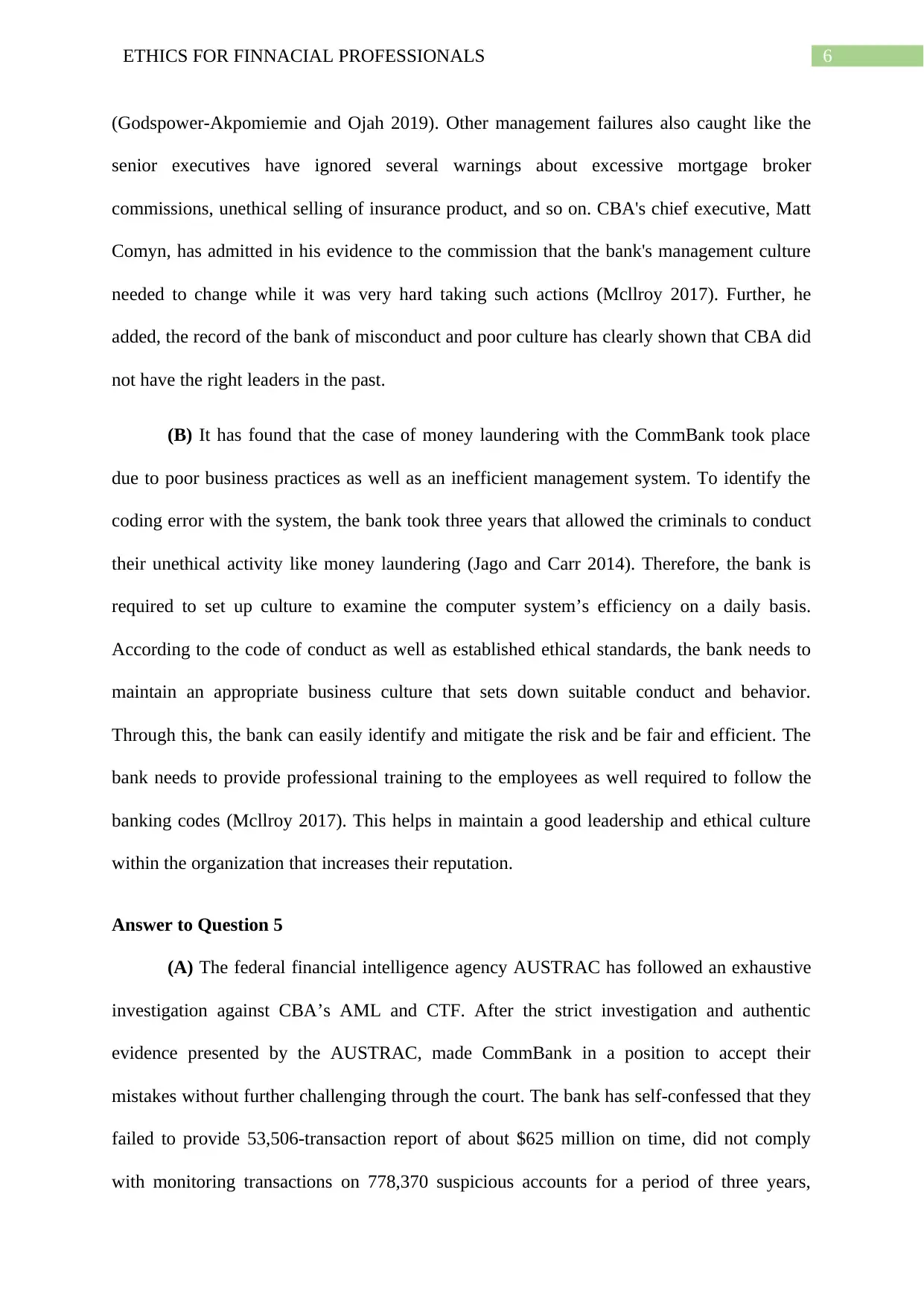
6ETHICS FOR FINNACIAL PROFESSIONALS
(Godspower-Akpomiemie and Ojah 2019). Other management failures also caught like the
senior executives have ignored several warnings about excessive mortgage broker
commissions, unethical selling of insurance product, and so on. CBA's chief executive, Matt
Comyn, has admitted in his evidence to the commission that the bank's management culture
needed to change while it was very hard taking such actions (Mcllroy 2017). Further, he
added, the record of the bank of misconduct and poor culture has clearly shown that CBA did
not have the right leaders in the past.
(B) It has found that the case of money laundering with the CommBank took place
due to poor business practices as well as an inefficient management system. To identify the
coding error with the system, the bank took three years that allowed the criminals to conduct
their unethical activity like money laundering (Jago and Carr 2014). Therefore, the bank is
required to set up culture to examine the computer system’s efficiency on a daily basis.
According to the code of conduct as well as established ethical standards, the bank needs to
maintain an appropriate business culture that sets down suitable conduct and behavior.
Through this, the bank can easily identify and mitigate the risk and be fair and efficient. The
bank needs to provide professional training to the employees as well required to follow the
banking codes (Mcllroy 2017). This helps in maintain a good leadership and ethical culture
within the organization that increases their reputation.
Answer to Question 5
(A) The federal financial intelligence agency AUSTRAC has followed an exhaustive
investigation against CBA’s AML and CTF. After the strict investigation and authentic
evidence presented by the AUSTRAC, made CommBank in a position to accept their
mistakes without further challenging through the court. The bank has self-confessed that they
failed to provide 53,506-transaction report of about $625 million on time, did not comply
with monitoring transactions on 778,370 suspicious accounts for a period of three years,
(Godspower-Akpomiemie and Ojah 2019). Other management failures also caught like the
senior executives have ignored several warnings about excessive mortgage broker
commissions, unethical selling of insurance product, and so on. CBA's chief executive, Matt
Comyn, has admitted in his evidence to the commission that the bank's management culture
needed to change while it was very hard taking such actions (Mcllroy 2017). Further, he
added, the record of the bank of misconduct and poor culture has clearly shown that CBA did
not have the right leaders in the past.
(B) It has found that the case of money laundering with the CommBank took place
due to poor business practices as well as an inefficient management system. To identify the
coding error with the system, the bank took three years that allowed the criminals to conduct
their unethical activity like money laundering (Jago and Carr 2014). Therefore, the bank is
required to set up culture to examine the computer system’s efficiency on a daily basis.
According to the code of conduct as well as established ethical standards, the bank needs to
maintain an appropriate business culture that sets down suitable conduct and behavior.
Through this, the bank can easily identify and mitigate the risk and be fair and efficient. The
bank needs to provide professional training to the employees as well required to follow the
banking codes (Mcllroy 2017). This helps in maintain a good leadership and ethical culture
within the organization that increases their reputation.
Answer to Question 5
(A) The federal financial intelligence agency AUSTRAC has followed an exhaustive
investigation against CBA’s AML and CTF. After the strict investigation and authentic
evidence presented by the AUSTRAC, made CommBank in a position to accept their
mistakes without further challenging through the court. The bank has self-confessed that they
failed to provide 53,506-transaction report of about $625 million on time, did not comply
with monitoring transactions on 778,370 suspicious accounts for a period of three years,
Paraphrase This Document
Need a fresh take? Get an instant paraphrase of this document with our AI Paraphraser
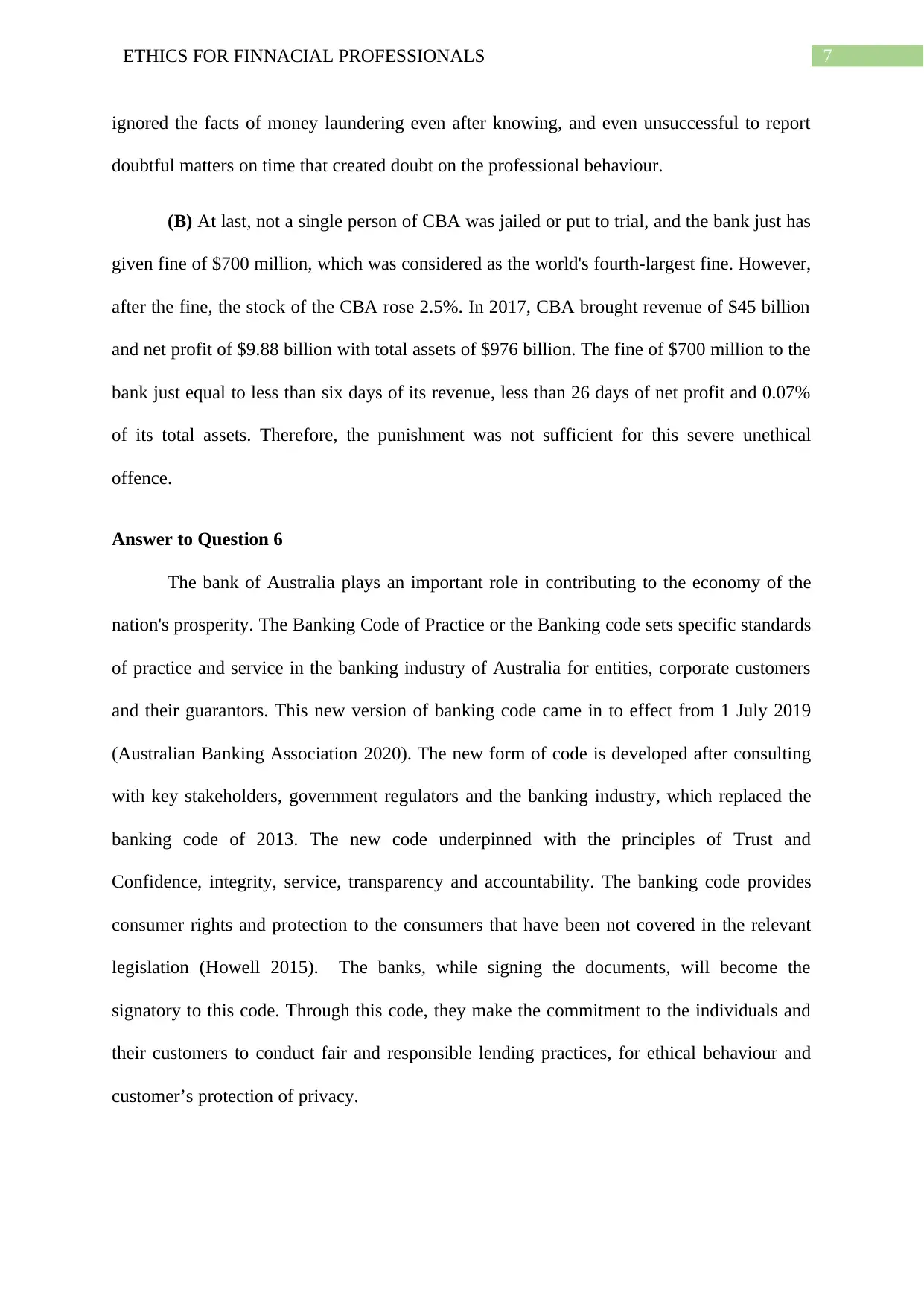
7ETHICS FOR FINNACIAL PROFESSIONALS
ignored the facts of money laundering even after knowing, and even unsuccessful to report
doubtful matters on time that created doubt on the professional behaviour.
(B) At last, not a single person of CBA was jailed or put to trial, and the bank just has
given fine of $700 million, which was considered as the world's fourth-largest fine. However,
after the fine, the stock of the CBA rose 2.5%. In 2017, CBA brought revenue of $45 billion
and net profit of $9.88 billion with total assets of $976 billion. The fine of $700 million to the
bank just equal to less than six days of its revenue, less than 26 days of net profit and 0.07%
of its total assets. Therefore, the punishment was not sufficient for this severe unethical
offence.
Answer to Question 6
The bank of Australia plays an important role in contributing to the economy of the
nation's prosperity. The Banking Code of Practice or the Banking code sets specific standards
of practice and service in the banking industry of Australia for entities, corporate customers
and their guarantors. This new version of banking code came in to effect from 1 July 2019
(Australian Banking Association 2020). The new form of code is developed after consulting
with key stakeholders, government regulators and the banking industry, which replaced the
banking code of 2013. The new code underpinned with the principles of Trust and
Confidence, integrity, service, transparency and accountability. The banking code provides
consumer rights and protection to the consumers that have been not covered in the relevant
legislation (Howell 2015). The banks, while signing the documents, will become the
signatory to this code. Through this code, they make the commitment to the individuals and
their customers to conduct fair and responsible lending practices, for ethical behaviour and
customer’s protection of privacy.
ignored the facts of money laundering even after knowing, and even unsuccessful to report
doubtful matters on time that created doubt on the professional behaviour.
(B) At last, not a single person of CBA was jailed or put to trial, and the bank just has
given fine of $700 million, which was considered as the world's fourth-largest fine. However,
after the fine, the stock of the CBA rose 2.5%. In 2017, CBA brought revenue of $45 billion
and net profit of $9.88 billion with total assets of $976 billion. The fine of $700 million to the
bank just equal to less than six days of its revenue, less than 26 days of net profit and 0.07%
of its total assets. Therefore, the punishment was not sufficient for this severe unethical
offence.
Answer to Question 6
The bank of Australia plays an important role in contributing to the economy of the
nation's prosperity. The Banking Code of Practice or the Banking code sets specific standards
of practice and service in the banking industry of Australia for entities, corporate customers
and their guarantors. This new version of banking code came in to effect from 1 July 2019
(Australian Banking Association 2020). The new form of code is developed after consulting
with key stakeholders, government regulators and the banking industry, which replaced the
banking code of 2013. The new code underpinned with the principles of Trust and
Confidence, integrity, service, transparency and accountability. The banking code provides
consumer rights and protection to the consumers that have been not covered in the relevant
legislation (Howell 2015). The banks, while signing the documents, will become the
signatory to this code. Through this code, they make the commitment to the individuals and
their customers to conduct fair and responsible lending practices, for ethical behaviour and
customer’s protection of privacy.
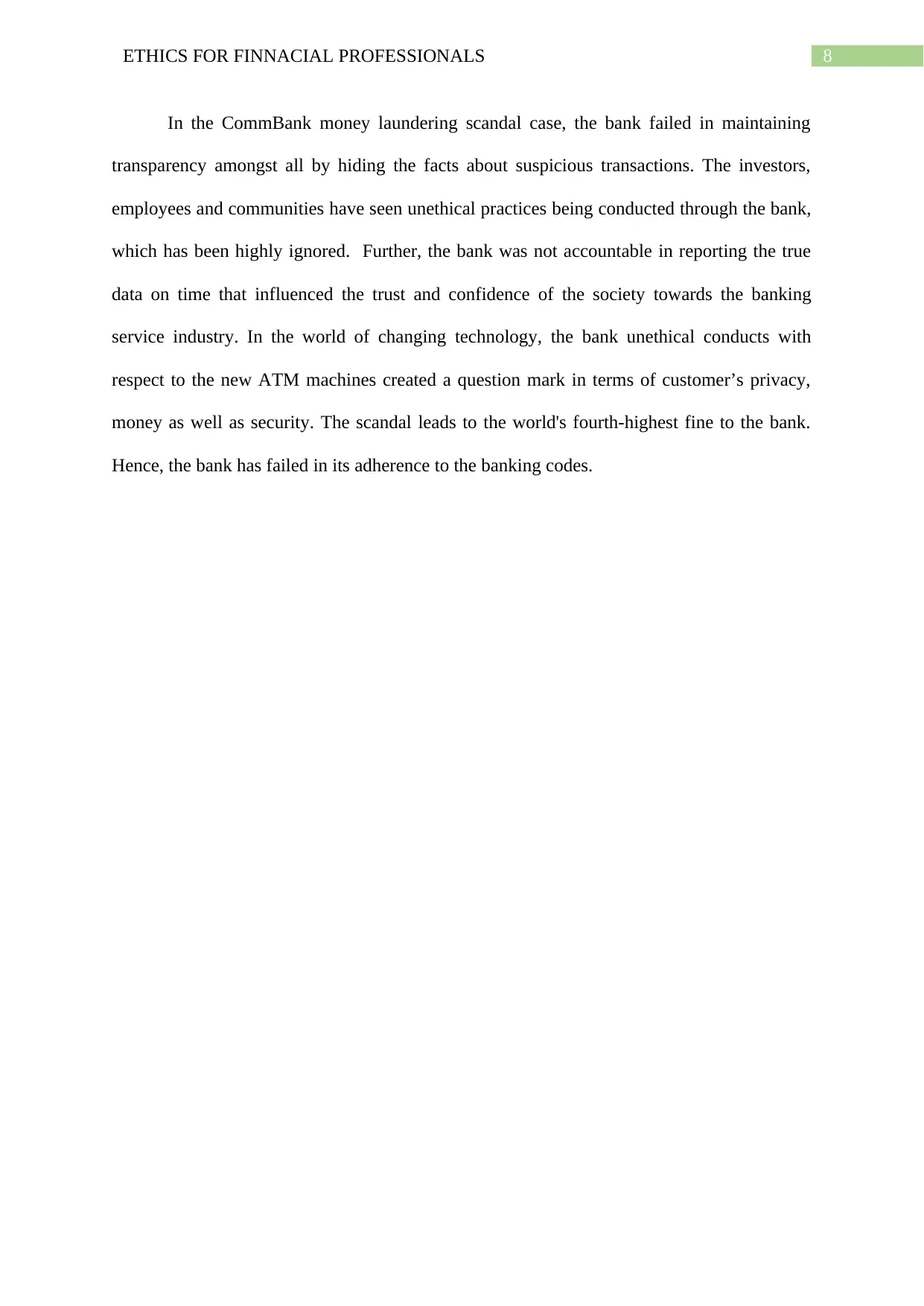
8ETHICS FOR FINNACIAL PROFESSIONALS
In the CommBank money laundering scandal case, the bank failed in maintaining
transparency amongst all by hiding the facts about suspicious transactions. The investors,
employees and communities have seen unethical practices being conducted through the bank,
which has been highly ignored. Further, the bank was not accountable in reporting the true
data on time that influenced the trust and confidence of the society towards the banking
service industry. In the world of changing technology, the bank unethical conducts with
respect to the new ATM machines created a question mark in terms of customer’s privacy,
money as well as security. The scandal leads to the world's fourth-highest fine to the bank.
Hence, the bank has failed in its adherence to the banking codes.
In the CommBank money laundering scandal case, the bank failed in maintaining
transparency amongst all by hiding the facts about suspicious transactions. The investors,
employees and communities have seen unethical practices being conducted through the bank,
which has been highly ignored. Further, the bank was not accountable in reporting the true
data on time that influenced the trust and confidence of the society towards the banking
service industry. In the world of changing technology, the bank unethical conducts with
respect to the new ATM machines created a question mark in terms of customer’s privacy,
money as well as security. The scandal leads to the world's fourth-highest fine to the bank.
Hence, the bank has failed in its adherence to the banking codes.
⊘ This is a preview!⊘
Do you want full access?
Subscribe today to unlock all pages.

Trusted by 1+ million students worldwide
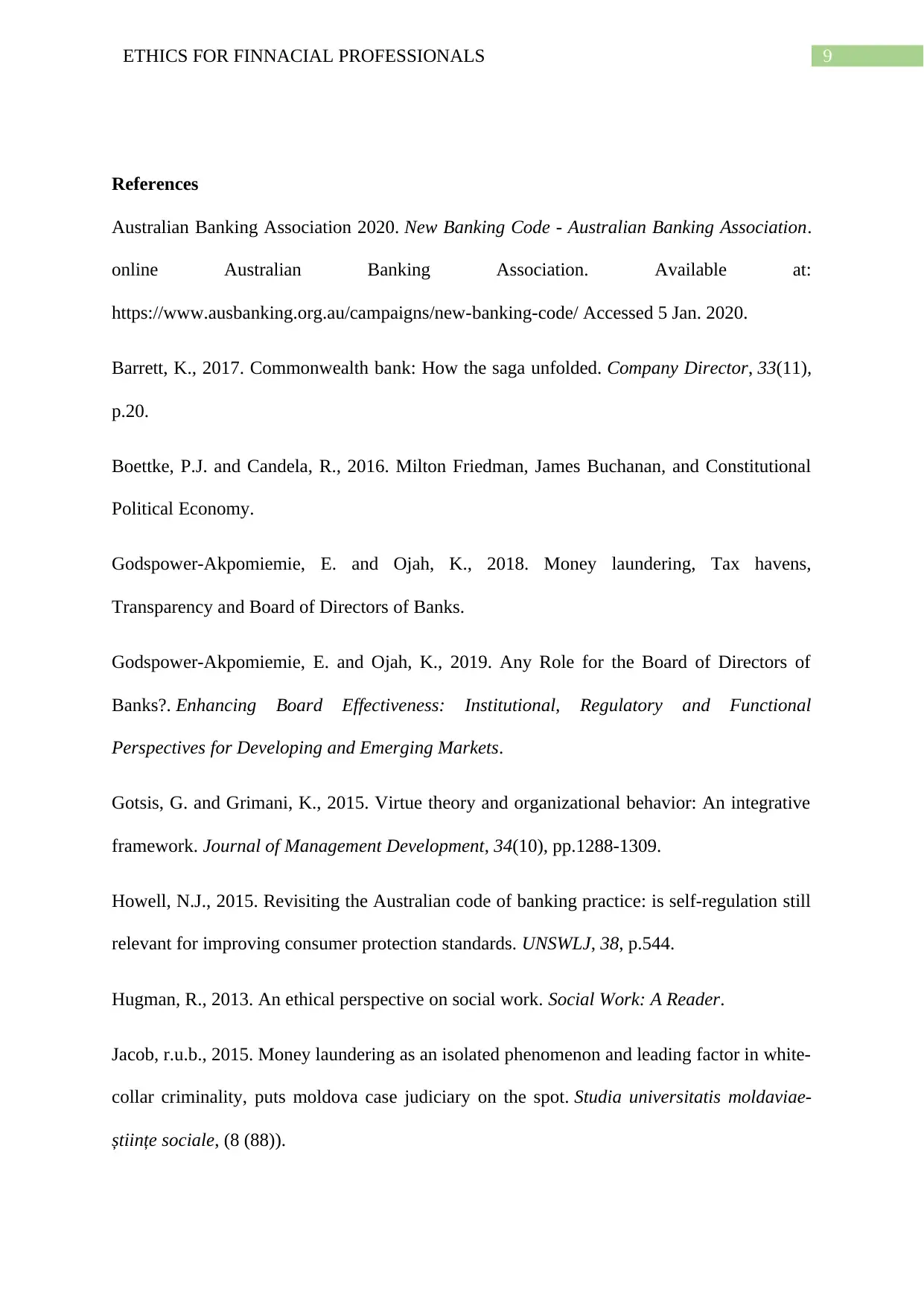
9ETHICS FOR FINNACIAL PROFESSIONALS
References
Australian Banking Association 2020. New Banking Code - Australian Banking Association.
online Australian Banking Association. Available at:
https://www.ausbanking.org.au/campaigns/new-banking-code/ Accessed 5 Jan. 2020.
Barrett, K., 2017. Commonwealth bank: How the saga unfolded. Company Director, 33(11),
p.20.
Boettke, P.J. and Candela, R., 2016. Milton Friedman, James Buchanan, and Constitutional
Political Economy.
Godspower-Akpomiemie, E. and Ojah, K., 2018. Money laundering, Tax havens,
Transparency and Board of Directors of Banks.
Godspower-Akpomiemie, E. and Ojah, K., 2019. Any Role for the Board of Directors of
Banks?. Enhancing Board Effectiveness: Institutional, Regulatory and Functional
Perspectives for Developing and Emerging Markets.
Gotsis, G. and Grimani, K., 2015. Virtue theory and organizational behavior: An integrative
framework. Journal of Management Development, 34(10), pp.1288-1309.
Howell, N.J., 2015. Revisiting the Australian code of banking practice: is self-regulation still
relevant for improving consumer protection standards. UNSWLJ, 38, p.544.
Hugman, R., 2013. An ethical perspective on social work. Social Work: A Reader.
Jacob, r.u.b., 2015. Money laundering as an isolated phenomenon and leading factor in white-
collar criminality, puts moldova case judiciary on the spot. Studia universitatis moldaviae-
științe sociale, (8 (88)).
References
Australian Banking Association 2020. New Banking Code - Australian Banking Association.
online Australian Banking Association. Available at:
https://www.ausbanking.org.au/campaigns/new-banking-code/ Accessed 5 Jan. 2020.
Barrett, K., 2017. Commonwealth bank: How the saga unfolded. Company Director, 33(11),
p.20.
Boettke, P.J. and Candela, R., 2016. Milton Friedman, James Buchanan, and Constitutional
Political Economy.
Godspower-Akpomiemie, E. and Ojah, K., 2018. Money laundering, Tax havens,
Transparency and Board of Directors of Banks.
Godspower-Akpomiemie, E. and Ojah, K., 2019. Any Role for the Board of Directors of
Banks?. Enhancing Board Effectiveness: Institutional, Regulatory and Functional
Perspectives for Developing and Emerging Markets.
Gotsis, G. and Grimani, K., 2015. Virtue theory and organizational behavior: An integrative
framework. Journal of Management Development, 34(10), pp.1288-1309.
Howell, N.J., 2015. Revisiting the Australian code of banking practice: is self-regulation still
relevant for improving consumer protection standards. UNSWLJ, 38, p.544.
Hugman, R., 2013. An ethical perspective on social work. Social Work: A Reader.
Jacob, r.u.b., 2015. Money laundering as an isolated phenomenon and leading factor in white-
collar criminality, puts moldova case judiciary on the spot. Studia universitatis moldaviae-
științe sociale, (8 (88)).
Paraphrase This Document
Need a fresh take? Get an instant paraphrase of this document with our AI Paraphraser
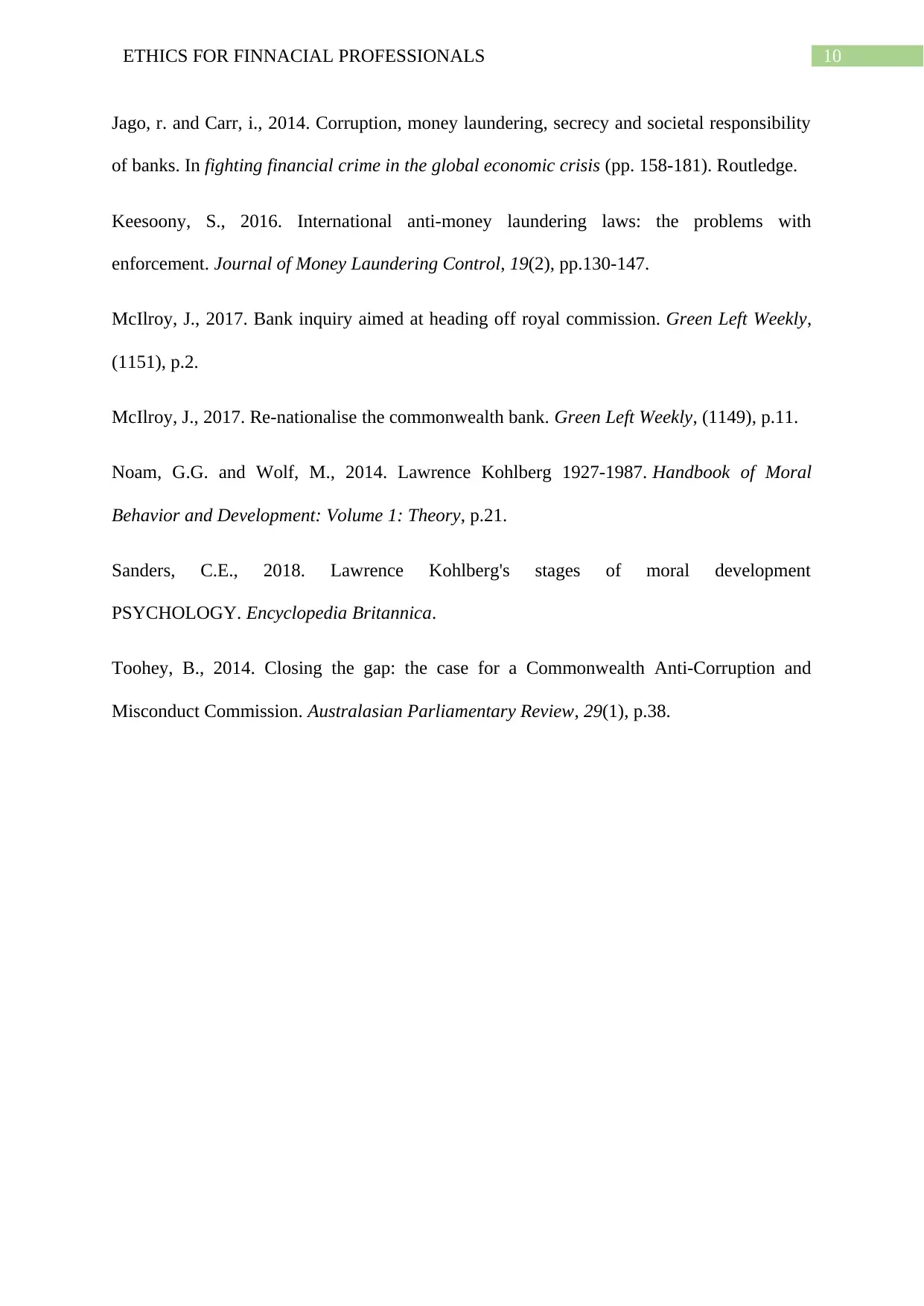
10ETHICS FOR FINNACIAL PROFESSIONALS
Jago, r. and Carr, i., 2014. Corruption, money laundering, secrecy and societal responsibility
of banks. In fighting financial crime in the global economic crisis (pp. 158-181). Routledge.
Keesoony, S., 2016. International anti-money laundering laws: the problems with
enforcement. Journal of Money Laundering Control, 19(2), pp.130-147.
McIlroy, J., 2017. Bank inquiry aimed at heading off royal commission. Green Left Weekly,
(1151), p.2.
McIlroy, J., 2017. Re-nationalise the commonwealth bank. Green Left Weekly, (1149), p.11.
Noam, G.G. and Wolf, M., 2014. Lawrence Kohlberg 1927-1987. Handbook of Moral
Behavior and Development: Volume 1: Theory, p.21.
Sanders, C.E., 2018. Lawrence Kohlberg's stages of moral development
PSYCHOLOGY. Encyclopedia Britannica.
Toohey, B., 2014. Closing the gap: the case for a Commonwealth Anti-Corruption and
Misconduct Commission. Australasian Parliamentary Review, 29(1), p.38.
Jago, r. and Carr, i., 2014. Corruption, money laundering, secrecy and societal responsibility
of banks. In fighting financial crime in the global economic crisis (pp. 158-181). Routledge.
Keesoony, S., 2016. International anti-money laundering laws: the problems with
enforcement. Journal of Money Laundering Control, 19(2), pp.130-147.
McIlroy, J., 2017. Bank inquiry aimed at heading off royal commission. Green Left Weekly,
(1151), p.2.
McIlroy, J., 2017. Re-nationalise the commonwealth bank. Green Left Weekly, (1149), p.11.
Noam, G.G. and Wolf, M., 2014. Lawrence Kohlberg 1927-1987. Handbook of Moral
Behavior and Development: Volume 1: Theory, p.21.
Sanders, C.E., 2018. Lawrence Kohlberg's stages of moral development
PSYCHOLOGY. Encyclopedia Britannica.
Toohey, B., 2014. Closing the gap: the case for a Commonwealth Anti-Corruption and
Misconduct Commission. Australasian Parliamentary Review, 29(1), p.38.
1 out of 11
Related Documents
Your All-in-One AI-Powered Toolkit for Academic Success.
+13062052269
info@desklib.com
Available 24*7 on WhatsApp / Email
![[object Object]](/_next/static/media/star-bottom.7253800d.svg)
Unlock your academic potential
Copyright © 2020–2025 A2Z Services. All Rights Reserved. Developed and managed by ZUCOL.



